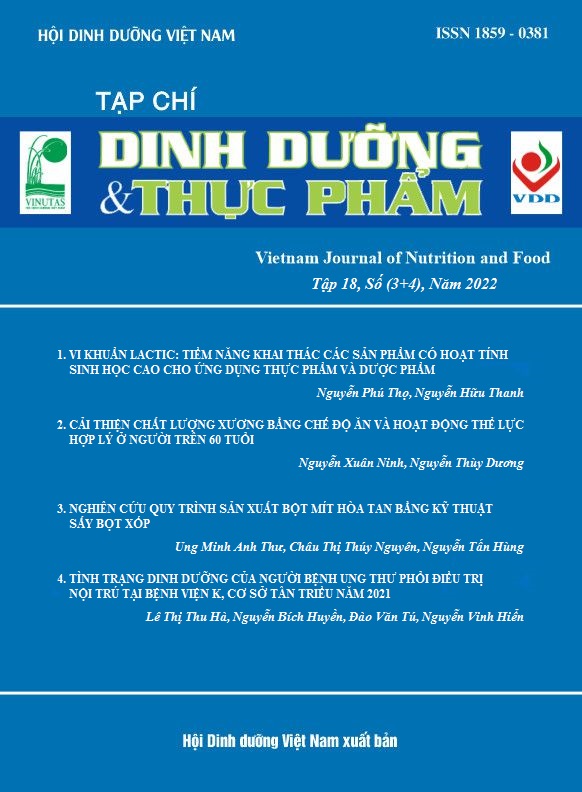NUTRITIONAL STATUS AND PHYSICAL ACTIVITIES OF MIGRANT EMPLOYEES AT A MANUFACTURER IN HO CHI MINH CITY
Main Article Content
Abstract
Aims: To assess overweight, obesity and physical activity status of migrant workers in Ho Chi Minh City.
Methods: A cross-sectional study was was carried on 320 migrant workers at a company Duc Bon Co., Ltd. Height was measured by French Microtoise ruler; weight and body fat percentage by Tanita SC–331S impedance measuring scale; measure physical activity by Global Physical Activities Questionnaire-GPAQv2. Body fat percentage is high when > 25% and > 30% in women; The WHO recommended level of physical activity is ≥ 600 MET-minutes/week.
Results: The percentage of overweight (BMI ≥ 25) was 22.8%, obesity (BMI ≥ 30) was 2.5% and high body fat percentage was 19.1%. The percentage of workers who met the WHO recommended level of physical activity was 60.9%. Employees who meet WHO's recommended levels of physical activity have a 0.28 times lower risk of becoming overweight or obese (0.17 - 0.48) compared with the rest of group.
Conclusion: The rate of obesity and overweight in migrant workers at Duc Bon Co., Ltd. is high compared to previous studies conducted in the city. Physical activities were significanly associated with overweight and obesity status of workers.
Keywords
Overweight, obesity, physical activity, migrant employees,
Article Details
References
2. Mai Thị Mỹ Thiện, Trần Thị Minh Hạnh, Nguyễn Nhân Thành và cs. Tình trạng dinh dưỡng công nhân nhập cư tại thành phố Hồ Chí Minh. Tạp chí Dinh Dưỡng Thực Phẩm. 2012;8(3):68-74.
3. Wang M, Xu PS, Liu W, et al. Prevalence and changes of BMI categories in China and related chronic diseases: Cross-sectional National Health Service Surveys (NHSSs) from 2013 to 2018. EClinicalMedicine. 2020;26:100521.
4. Popkin BM. Global nutrition dynamics: the world is shifting rapidly toward a diet linked with noncommunicable diseases. Am J Clin Nutr. 2006;84(2):289-298.
5. Prentice AM. The emerging epidemic of obesity in developing countries. Int J Epidemiol. 2006;35(1):93-99.
6. Shohaimi S, Welch A, Bingham S, et al. Residential area deprivation predicts fruit and vegetable consumption independently of individual educational level and occupational social class: a cross sectional population study in the Norfolk cohort of the European Prospective Investigation into Cancer (EPIC-Norfolk). J Epidemiol Community Health. 2004;58(8):686-691.
7. Van Lenthe FJ, Mackenbach JP. Neighbourhood deprivation and overweight: the GLOBE study. Int J Obes Relat Metab Disord J Int Assoc Study Obes. 2002;26(2):234-240.
8. Viện Dinh dưỡng quốc gia. Một Số Kết Quả Chính Tổng Điều Tra Dinh Dưỡng 2019-2020. Trung tâm giáo dục truyền thông Dinh dưỡng; 2020.
9. Bui TV, Blizzard CL, Luong KN, et al. Physical Activity in Vietnam: Estimates and Measurement Issues. PLOS ONE. 2015;10(10):e0140941.
10. Anderson LM, Quinn TA, Glanz K, et al. The Effectiveness of Worksite Nutrition and Physical Activity Interventions for Controlling Employee Overweight and Obesity: A Systematic Review. Am J Prev Med. 2009;37(4):340-357.
11. Lê Thị Diễm Trinh. Tỷ lệ sử dụng rượu bia và một số yếu tố liên quan ở người lao động nhập cư trên 18 tuổi xã Tân Phú Trung, huyện Củ Chi, Thành phố Hồ Chí Minh. Đại học Y Dược Thành Phố Hồ Chí Minh. 2018.
12. Prevention of Noncommunicable Diseases Department World Health Organization. Global Physical Activity Questionnaire (GPAQ) Analysis Guide. Published online 2010.
13. Phạm Ngọc Oanh, Mai Thị Mỹ Thiện, Phạm Nhật Thùy Đan và cs. Hoạt động thể lực, tình trạng dinh dưỡng, chế độ ăn của nhân viên công tác tại một số cơ sở y tế tại thành phố Hồ Chí Minh và các tỉnh phía nam. Tạp chí Dinh Dưỡng và Thực Phẩm. 2018;14(4):38-45.
14. Bộ Y tế. Kết quả Điều tra quốc gia yếu tố nguy cơ bệnh không lây nhiễm năm 2015.
15. Nguyển Thị Hồng Minh, Nguyễn Thị Lâm, Phùng Thị Liên và cs. Thực trạng Thừa cân béo phì và rối loạn lipid máu của sĩ quan thuộc Bộ tư lệnh bộ đội biên phòng tại Hà Nội. Tạp chí Dinh Dưỡng và Thực Phẩm. 2010;6(3+4).


